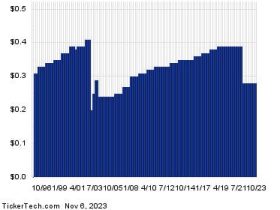It’s time to hunt for bargains.
That’s Matt Miskin, John Hancock Investment Management’s co-chief investment strategist, telling investors to focus on unloved sectors of the market now that the Federal Reserve has indicated interest rates could stay higher for longer than previously anticipated.
“We are in a late-cycle environment, in our view,” Miskin told MarketWatch. “The markets were fighting the Fed — and they were winning,” he said. “And then the Fed last week said: ‘We are fighting back.’”
See: Interest rates will stay high ‘well into next year,’ Fed’s Goolsbee says
Last week, the central bank kept its policy rate at a 22-year high, but erased two of four rate cuts previously penciled in for next year, with its so-called “dot plot” now showing a benchmark Fed rate that could stay above 5% through the end of 2024.
That creates a backdrop that could strain consumers and dent sales of luxury vehicles and other high-end consumer items, he said. But it has already sparked extremes in the roughly $25 trillion Treasury market, with the 10-year yield
BX: TMUBMUSD10Y
climbing 10 basis points on Monday to 4.541%, its loftiest level since October 2007.
“I think we are at the point in the cycle where yields are going to back up until something breaks,” Miskin said. “Right now, the sentiment is pretty dire out there.”
Older bonds with lower coupons fall in price as yields rise, often hurting total returns on bond portfolios. As evidence of the pain hitting long U.S. government bonds, shares of the popular iShares 20+ Year Treasury Bond ETF
TLT
fell below $90 a share on Monday, its lowest level in more than 12 years.
However, Miskin also thinks it’s a rare opportunity to buy beaten-up bonds, where “the math is pretty favorable for those investors that are long term,” and defensive stocks that reflect “what people need, not what they want.”
That includes heath care, utilities and consumer staples, which have been out of favor this year as investors gravitated to a small number of high-flying technology companies as recession fears faded.
Read: A major stock-market shift that Wall Street has been waiting for all year is finally starting. But can it last?
As a sign the shift may be starting, the S&P 500’s tech sector is down more than 6% in September, through Monday, while defensive sectors like utilities and energy are on pace for monthly gains of 1% and 2.5%, respectively, according to FactSet.
“When recession risk is minimal, the defensive parts of the market are going to be the most on sale, and when you want to buy these things,” Miskin said. “You don’t buy the hurricane insurance when the hurricane is there.”
That also includes energy, particularly given supply constraints that have kept U.S.
CL00,
and international
BRN00,
crude prices near $90 a barrel.
The S&P 500,
SPX
Dow Jones Industrial Average
DJIA
and Nasdaq Composite Index
COMP
posted modest gains on Monday, but were still on pace for losses in September.
Read the full article here











Leave a Reply